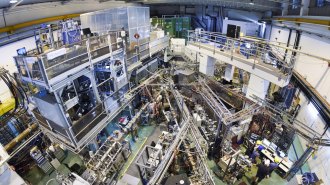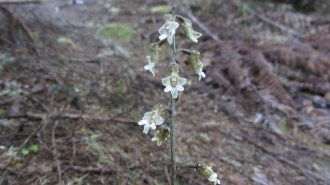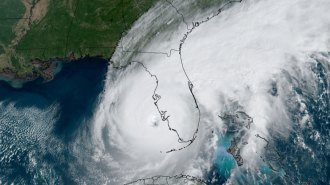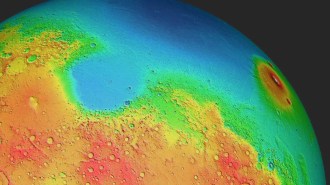All Stories
-
 Life
LifeCoral reefs host millions of bacteria, revealing Earth’s hidden biodiversity
A new estimate of microbial life living in Pacific reefs is similar to global counts, suggesting many more microbes call Earth home than thought.
-
 Physics
PhysicsMeasurements of a key radioactive decay nudge a nuclear clock closer to reality
In a step toward building a nuclear clock, scientists measured light emitted when a special type of thorium nucleus decayed.
-
 Animals
AnimalsThese ants build tall nest hills to help show the way home
Desert ants living in the harsh, flat salt pans of Tunisia create towering anthills to aid with navigating the near-featureless terrain.
By Soumya Sagar -
 Animals
AnimalsHow a new Lyme vaccine for mice may protect people
A vaccine, distributed as pellets, can neutralize Lyme-causing bacteria in wildlife. Scientists hope it will reduce Lyme exposure for people and pets.
-
 Quantum Physics
Quantum PhysicsQuantum computers braided ‘anyons,’ long-sought quasiparticles with memory
Particle-like quantum states called non-abelian anyons remember being swapped and could be useful for protecting information in quantum computers.
-
 Health & Medicine
Health & MedicineWith tools from Silicon Valley, Quinton Smith builds lab-made organs
Tissues made with 3-D printing and other techniques could offer insights into diseases such as fatty liver disease and preeclampsia.
-

Charting a course for the future of Science News
Editor in chief Nancy Shute reflects on the history and future of Science News.
By Nancy Shute -
 Plants
PlantsA hunt for fungi might bring this orchid back from the brink
Identifying the fungi that feeds the Cooper’s black orchid in the lab may allow researchers to bank seeds and possibly regrow the species in the wild.
-

-
 Climate
ClimateWhy the 2023 Atlantic hurricane season is especially hard to predict
It’s hard to know how busy this year’s Atlantic hurricane season will be, thanks to a rarely observed combination of ocean and climate conditions.
-
 Planetary Science
Planetary ScienceA quake on Mars showed its crust is thicker than Earth’s
Seismic data from NASA’s Insight lander reveal the crust is roughly 50 kilometers thick, with the northern crust being thinner than the south’s.
-
 Environment
EnvironmentThis house was built partly from recycled diapers
Disposable diapers can replace nearly a third of the materials used in load-bearing structures, offering a potential path to more affordable housing.